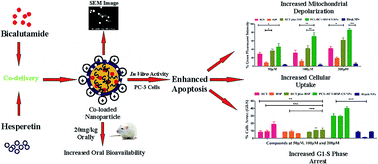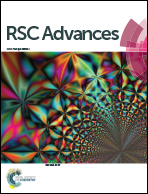Co-delivery of hesperetin enhanced bicalutamide induced apoptosis by exploiting mitochondrial membrane potential via polymeric nanoparticles in a PC-3 cell line†
Abstract
In this research, we reported the co-delivery of anti-androgen drug Bicalutamide (BCT) with Hesperetin (HSP) in chitosan (CS) coated polycaprolactone (PCL) nanoparticles (NPs) to increase their therapeutic efficacy against an androgen independent prostate cancer cell line. The PCL-BCT-HSP-CS NPs were prepared by anti-solvent precipitation followed by ionic gelation method, and showed narrow particle size distribution, high encapsulation efficiency (about 90%) and sustained drug release behavior for both drugs. During the preparation of NPs; HSP crystallinity was retained, whereas polymorphic transition of BCT from form I to form II was observed by thermogravimetric analysis. Additionally, DPPH radical scavenging assay confirmed the structural integrity of HSP in the NPs. The kinetic solubility of BCT and HSP in the NPs was increased by 61.66 and 6.75 fold, respectively, as compared to the free drugs. Further, the in vitro therapeutic efficacy of co-loaded PCL-BCT-HSP-CS NPs was compared with free BCT, HSP and their combination (BCT plus HSP) in androgen independent PC-3 cell lines. Interestingly, co-loaded NPs exhibited higher in vitro cytotoxicity by G1-S phase cell cycle arrest and apoptosis at equivalent concentrations. This superior activity may be attributed to enhanced mitochondrial membrane potential loss by co-loaded NPs. Cell uptake study showed significantly higher (P < 0.05) uptake of NPs by cancer cells. Additionally, in vivo pharmacokinetics of NPs were explored in SD male rats and revealed higher AUC0–t and Cmax of BCT (1.46 and 1.42 fold) and HSP (4.16 and 3.79 fold) than an aqueous suspension when administered orally at 20 mg kg−1. We demonstrated that co-delivery with HSP via polymeric NPs might have better therapeutic potential for in vitro management of androgen independent prostate cancer.


 Please wait while we load your content...
Please wait while we load your content...